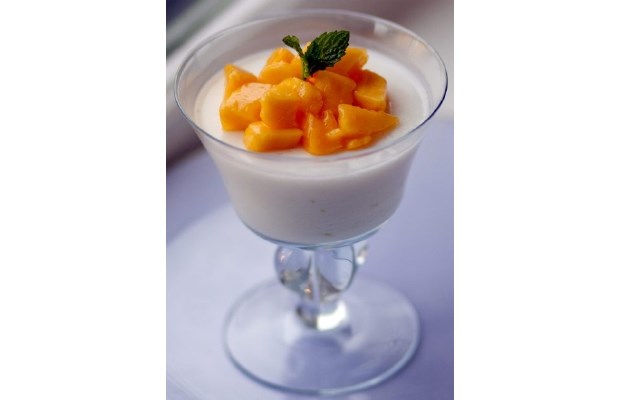Q There are two types of canned coconut milk - one much lower in calories and not as thick as the other. How do you know which to use in a recipe? Is one type more suitable for desserts? Most recipes just say coconut milk, so I usually go for the lower-calorie one, but I guess there is a difference in the flavour.
Barb Myatt, Comox
A To make canned coconut milk, the flesh of the fruit is pressed and a milklike substance extracted. Water is added to get the desired consistency and so, often, is guar gum. Guar gum is made from the seeds of the guar plant and is used to stabilize or thicken foods.
Despite that stabilizer, coconut milk can separate in the can, with thick coconut milk rising and settling on top, and a watery mixture sitting on the bottom. This separation is normal and some say a sign of good-quality coconut milk. Shake the can well before opening. Any solids will also liquefy once heated.
One store brand of coconut milk I found also contained sulphites, another preservative, which you can find listed on some bags of dried coconut flakes. If you want to avoid sulphites, read the label before purchasing.
In Southeast Asia and other tropical regions, coconut milk has long been a staple ingredient. In our part of the world, though, coconut milk sometimes gets a bad rap because of its saturated fat content.
However, this form of saturated fat is easy to metabolize, can provide quick energy and its principal fatty acid, lauric acid, is the same fat found in human mother's milk.
That said, coconut milk is fairly high in calories and concerns about that and its saturated fat led to the invention of a product containing less of both: light (or lite) coconut milk.
The label of Thai Kitchen brand coconut milk says one quarter cup contains 120 calories and 16 per cent of your daily recommended fat intake. A quarter cup of Thai Kitchen lite coconut milk contains 40 calories and five per cent of your daily recommended fat.
Quite a difference, but why? Light coconut milk contains the same ingredients as regular coconut milk; it just contains more water. On Thai Kitchen brand regular coconut milk, the ingredients are listed as coconut milk, water and guar gum. On its light product, it's water, coconut milk and guar gum.
In my experience, when a recipe calls for canned coconut milk, the regular version was used when testing the recipe. If the recipe creator wanted to use light coconut milk, he would or should have noted that. With added water, naturally, light coconut milk won't be as full-flavoured as regular coconut milk, which is why most recipe creators prefer to use the latter. In fact, some chefs and food bloggers describe light coconut milk as an inferior product. They suggest that if you want to "lighten" a dish, such as a curry or soup, you should simply thin out regular coconut milk with a flavourful liquid, such as good stock, depending on the recipe.
Thai Kitchen's website offers dozens of recipes using regular coconut milk, but none specifically for the light product. A Taste of Thai (atasteofthai.com), another company selling coconut milk, offers 133 online recipes using regular coconut milk, and just five for light coconut milk.
Barb, the bottom line is that if a recipe calls for canned coconut milk, in most cases, including today's dessert recipe, regular or light coconut milk could be used. For the richest taste, I think you know which one will deliver.
Note: Just so you know, as a comparison, 1/4 cup of another ingredient used to add a creamy taste to foods, whipping cream, contains 200 calories and 24 per cent of your daily recommended fat intake.
COCONUT LIME PANNA COTTA WITH TROPICAL FRUIT
This dairy-free version of the classic Italian dessert can be made with regular or light coconut milk. For the creamiest taste and richest flavour, regular coconut milk would deliver the best results. For a lighter taste and texture, light coconut milk would be your best bet.
Preparation time: 15 minutes
Cooking time: About 3 to 4 minutes
Makes: 4 servings
1 tsp. finely grated lime zest
2 Tbsp. lime juice
1 packet (about 2 tsp) unflavoured gelatin, such as Knox brand
1/4 cup granulated sugar
1 (14-oz.) can regular or light coconut milk
1 cup cubed (small, about 1/2inch) fresh papaya or mango
1 Tbsp. icing sugar
4 fresh mint sprigs
Place the zest and lime juice in a small pot. Sprinkle with the gelatin and let stand 5 minutes. Add the coconut milk and sugar to the pot. Place over medium heat and bring the mixture just to scalding point, stirring occasionally to dissolve the sugar and gelatin. Divide and pour the mixture into 4, 8-oz. heatproof (won't crack with hot liquid in them) decorative glasses. Cool to room temperature. Cover and refrigerate until set, 4 hours, or overnight.
When ready to serve, place the papaya or mango and icing sugar in a small bowl and toss to combine. Spoon some fruit into the centre of each panna cotta. Garnish each dish with mint and serve.
Eric Akis is the author of the bestselling Everyone Can Cook series of cookbooks. His columns appear in the Life section Wednesday and Sunday.



